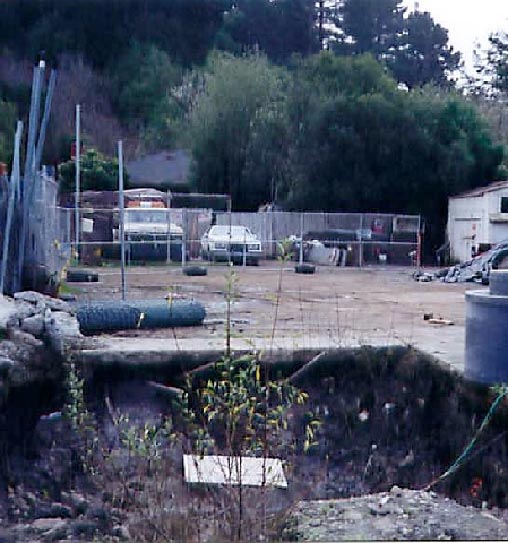
Brownfield sites, San Francisco Bay Reqional Water Quality Control Board. (Photo: waterboards.ca.gov)
The Uncertain Future of Brownfield Redevelopment in California
Understanding the impact of Cal EPA’s Supplemental Vapor Intrusion Guidance
By Thierry Montoya, May 1, 2024 2:00 pm
The Center for Creative Land Recycling estimates that California faces the challenge of managing approximately 200,000 brownfield sites – underutilized, abandoned, or contaminated properties, often resulting from industrial activities. While these sites present opportunities for urban redevelopment, environmental remediation, economic development, and sustainable growth, they also pose environmental, legal, and financial risks.
The redevelopment of brownfields is fraught with complexities, especially those involving Vapor Intrusion (VI) — the process by which volatile chemicals from contaminated soil or groundwater seep into indoor air spaces, potentially impacting indoor air quality and public health. In response, CalEPA issued Supplemental Vapor Intrusion Guidance in February 2023 to enhance the assessment and management of health risks associated with VI at brownfield sites.
This guidance outlines a systematic approach to VI assessment, starting with an evaluation of a building’s proximity to potential VI sources, followed by indoor and outdoor air testing to detect Vapor-Forming Compounds (VFCs). The guidance also emphasizes considering sewers and subsurface networks as potential pathways for VFC migration, advocating for a more detailed testing approach.
A significant debate centers around the guidance’s recommendation on attenuation factors (AFs), which are used to estimate the reduction in concentration of contaminants as they migrate from their source to a point of exposure. The guidance proposes a specific 0.03 AF, which is more conservative compared to the previously used 0.001 or 0.002, suggesting that a larger portion of the contaminant is expected to reach indoor environments, thereby necessitating investigation across a much wider geographic area, often including adjacent properties. The result is a quagmire that delays the start of cleanup and causes impediments to site closure. This has sparked debate, with some peer-reviewed studies, such as this one recommending lower AFs based on California-specific conditions, arguing that the 0.03 AF may not be scientifically warranted and could inflate remediation costs unnecessarily.
The implications of this guidance for brownfield redevelopment in California are significant. Commercial lenders often require a Phase I Environmental Site Assessment to identify potential contamination risks. If assessments based on the 0.03 AF indicate significant VI risks, more sites will be classified as having significant environmental issues, potentially derailing real estate transactions due to lender denial. Furthermore, if a loan for a brownfield site is secured, developers working with CalEPA’s regulatory bodies to remediate VI are entitled to propose alternative assessment methods for VI intrusion. However, there’s concern among developers that the 0.03 AF is being treated more as a cleanup goal than a screening tool, leading to increased remediation costs due to the requirements for additional indoor air testing and the implementation of active vapor extraction barriers that may need to operate for years.
As explained by Matt Winefield of Winefield & Associates in a 2021 article focused on brownfield regulation, “Spending millions on a site for a decade before it can be redeveloped is a non-starter for most commercial operations. Without commercial or residential developers taking on brownfield sites, most will stay that way.”
The discussion surrounding CalEPA’s VI guidance, and the use of a 0.03 AF underscores the complex relationship between environmental health regulations and the objectives of brownfield redevelopment in California. The challenge lies in finding a balance that protects public health and safety while enabling the effective redevelopment of contaminated sites, a critical endeavor for the state’s dire housing needs and environmental sustainability goals.
To manage the risk of VI to indoor air, one approach is to memorialize the prior, less conservative AFs, such as 0.001 or 0.002. These levels have been shown by numerous studies to be protective of public health. Additionally, it’s important to evaluate the VI risks at each contaminated (brownfield) site individually, using multiple lines of evidence to understand the specific ways VI might occur there, based on the unique conditions of the site. While an initial AF may indicate a potential VI threat, further detailed analysis of the site, including soil gas levels and how vapors move through the ground, can provide a clearer picture of the actual risk to indoor air quality at that specific location.





So the unelected bureaucrats at CalEPA issued Supplemental Vapor Intrusion Guidance in February 2023 to enhance the assessment and management of health risks associated with VI at brownfield sites? No doubt the criminal Democrat mafia that controls the state would be willing to ignore CalEPA’s “guidance” if the price was right (aka payoffs)?